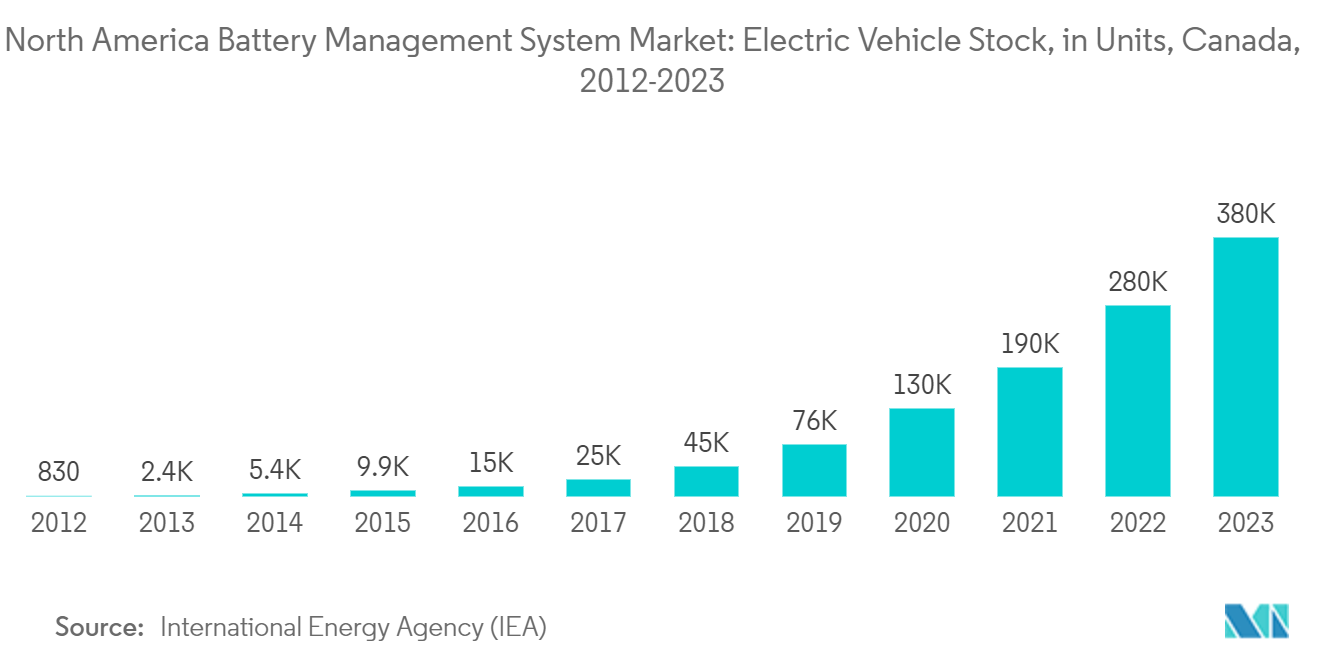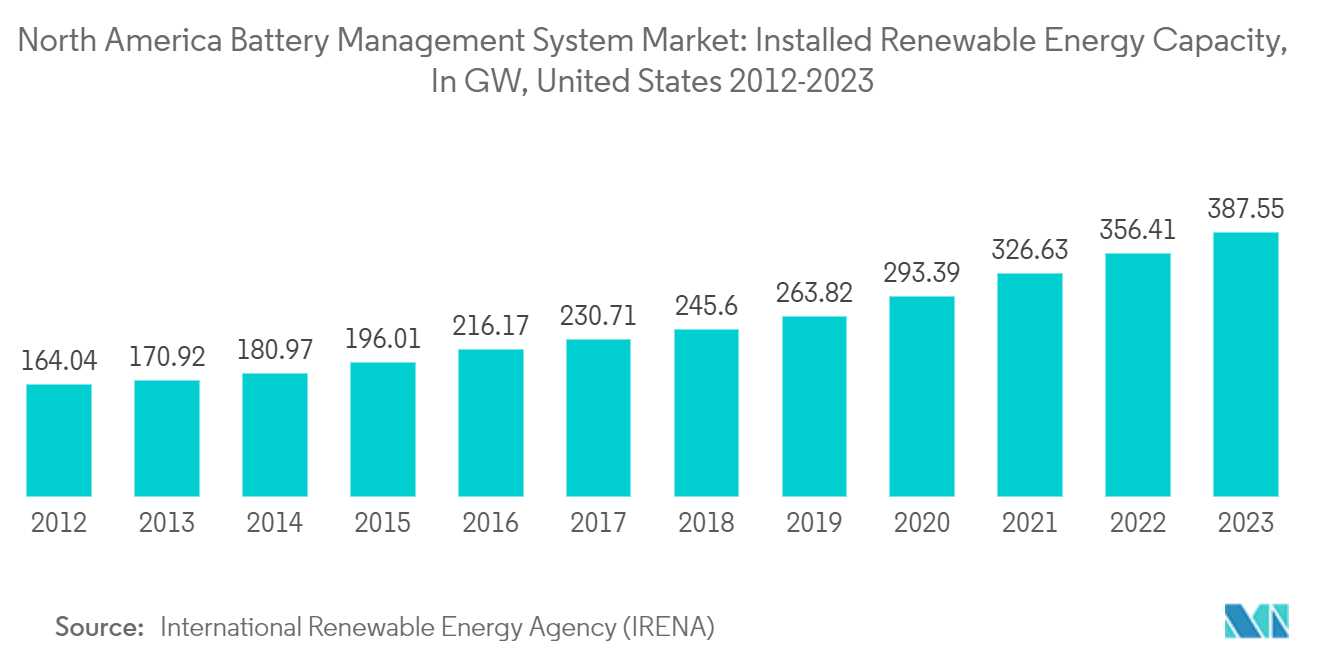Market Trends of North America Battery Management System Industry
Transportation Segment Expected to Dominate the Market
- Vehicles with internal combustion engines (ICE) were the only types used earlier. However, technology has been shifting toward electric vehicles (EVs) in line with growing environmental concerns. Therefore, due to these reasons, battery management systems do not hold any share in the internal combustion engine market.
- Lithium-ion batteries are primarily used in electric vehicles as they provide high energy density, low self-discharge, less weight, and low maintenance. For internal combustion engine vehicles, the lead-based battery is being widely used and is expected to continue to be the only viable mass-market battery system for the foreseeable future. For use in SLI applications, lithium-ion batteries still require higher cost reductions to be considered a viable mass-market alternative to lead-based batteries.
- Lithium-ion battery systems propel plug-in hybrid and electric vehicles. Owing to their high energy density, fast recharge capability, and high discharge power, lithium-ion batteries are the only available technology capable of meeting the requirements of original equipment manufacturers for the vehicle’s driving range and charging time. Lead-based traction batteries are not competitive for use in full hybrid electric vehicles or electric vehicles because of their lower specific energy and higher weight.
- Mexico is witnessing rapid growth in its electric vehicle manufacturing market. In March 2023, the Mexican government announced its intention for EVs to account for half of all cars sold domestically by 2030. Particularly, with Tesla Inc.'s plan to open a USD 5 billion Gigafactory in Mexico, the country is expected to become a production hub of electric vehicles. Such initiatives are likely to raise the sales of electric vehicles across the country and boost the demand for lithium-ion batteries for electric vehicles during the forecast period.
- In addition, in February 2024, BYD Co. Ltd, a prominent Chinese electric vehicle (EV) manufacturer, announced that it was in the process of establishing a new manufacturing plant in Mexico. The company has initiated a feasibility study for this venture and is actively engaged in discussions with Mexican officials, particularly focusing on finalizing the factory's precise location.
- Similar to the United States, the Canadian automobile industry is also undergoing a transition, with most auto producers pivoting toward electrification by setting up new plants or repurposing older plants to produce EVs.
- For instance, in April 2024, Honda Motor announced that it was set to inject a substantial USD 11 billion into new electric vehicle and battery production plants in Ontario, augmenting its current setup. This would mark the company's most significant investment in Canada to date. The initiative aims to kick off operations by 2028, boasting an anticipated annual production capacity of up to 240,000 electric vehicles.
- According to the Energy Information Agency (EIA), as of 2023, Canada's electric vehicle stock was recorded at approximately 38 thousand units, up by nearly 35.71% from stock volumes recorded in 2022.
- Thus, based on the abovementioned factors, the transportation segment is likely to dominate the North American battery management systems market during the forecast period.

The United States Expected to Dominate the Market
- The United States was projected to be one of the largest global markets for energy storage systems and electric vehicles in 2023. Both the end-user segments utilize battery management systems (BMS) to ensure the battery system’s adequate performance. Due to the high demand from these two massive end-user industries, the country is expected to be one of the most prominent and fastest-growing regional markets for battery management systems during the forecast period.
- The United States has one of the world's most well-developed automotive industries. As climate and environmental concerns are rising, most automakers in the country have prioritized the production of electric vehicles. Additionally, the US government has focused on increasing its electric vehicle fleet to reduce fossil fuel dependence and emissions.
- According to the Energy Information Agency (EIA), as of 2023, EV stock in the United States was approximately 3.5 million, up by nearly 66.67% from 2022 stock volumes, making it the second largest global EV market after China.
- As of 2023, the country had a renewable energy capacity of around 387.54 GW, an increase of around 8.7% compared to the previous year. In the upcoming years, renewable capacity in the country is likely to increase through targets that include having 80% new power generation capacity of clean energy by 2030. Further, the country aims to have 30 GW of offshore wind by 2030 and 110 GW by 2050.
- Due to this rapid rise in renewable generation, grid stability has become a major issue in countries with a high level of renewable integration in their grids. Nearly 66% of the installed renewable energy capacity in the United States is from wind and solar, which are inherently variable energy sources. Energy storage systems are needed to store renewable energy generation during high generation periods and release it during peak demand, while battery management systems dictate the efficiency and operation of these systems.
- The United States is expected to witness the development of massive battery farms, which are expected to provide utility-scale energy storage. These utility-scale systems are to be monitored and operated via a sophisticated battery management system, which is expected to allow bi-directional energy flow and battery optimization to improve battery life while maximizing efficiency and minimizing accidents.
- In April 2024, Equinor, a company dedicated to high-value growth in renewables and aspiring to lead the energy transition, greenlit its inaugural US battery storage ventures. These two projects, collectively boasting a 110 MW capacity, are poised to enhance energy security for the Texas grid. The Sunset Ridge Energy Center, located in Frio County, Texas, is already under construction, while preparations are underway for the Citrus Flatts project in Cameron County, Texas. The 10 MW/20 MWh battery storage at Sunset Ridge aims to bolster reliability, especially during peak demand, ensuring better service for Equinor's customers. Sunset Ridge is slated for commercial operation in the latter half of 2024. On the other hand, Citrus Flatts, a more substantial 100 MW/200 MWh project, will link up with American Electric Power's transmission network and is anticipated to commence commercial operations in early 2026.
- The abovementioned factors are driving the US battery management systems market, which is expected to grow further during the forecast period.


